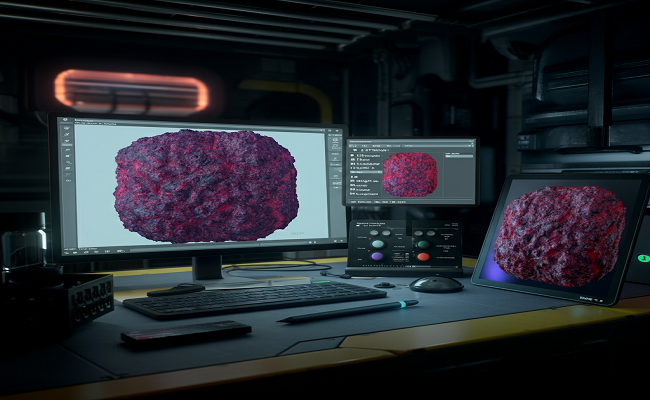
What is 1.5f8-p1uzt Texture?
The 1.5f8-p1uzt texture is a specialized structural formation primarily found in the realms of material science and engineering. This unique texture is characterized by its specific physical and chemical properties, which allow it to be utilized in various industrial applications. It is essential to identify that the term “1.5f8-p1uzt” represents a particular arrangement or sequence of atoms within a material, resulting in distinctive performance characteristics and behaviors under defined conditions.
The origins of the 1.5f8-p1uzt texture trace back to advancements in the study of crystalline structures and the properties of materials at a molecular level. Researchers discovered that manipulating atomic arrangements could lead to improved strength, durability, and functionality in materials, paving the way for innovations across multiple sectors such as aerospace, automotive, and electronics. Understanding the formation and implications of this texture is crucial for engineers and scientists working to optimize material performance.
In terms of its physical properties, the 1.5f8-p1uzt texture is known for offering exceptional tensile strength while maintaining a lightweight structure. The chemical stability of materials exhibiting this texture contributes significantly to their longevity and resistance to environmental factors. When compared to alternative textures, such as lamellar or dendritic formations, the 1.5f8-p1uzt texture distinguishes itself by providing a combination of optimal flexibility and robust resistance to stress and strain.
Overall, this analysis of the 1.5f8-p1uzt texture reveals its critical role in enhancing material capabilities—ultimately ensuring that products can withstand demanding conditions while retaining their functionality. Understanding these nuances is essential not only for material scientists but also for industries reliant on high-performance materials.
Applications of 1.5f8-p1uzt Texture
The 1.5f8-p1uzt texture has emerged as a significant element across various industries, leading to innovative applications that enhance product quality and performance. In the field of material science, this texture is often utilized to improve the mechanical properties of composites. For instance, researchers have shown that integrating 1.5f8-p1uzt texture into polymer blends can increase tensile strength and durability, making these materials more suitable for demanding applications, such as aerospace and automotive components.
In manufacturing, the utilization of 1.5f8-p1uzt texture is pivotal in precision engineering. Companies have adopted this texture in the production of various machined parts, where its unique properties contribute to better surface smoothness and reduced friction. For example, components in high-performance engines benefit from lower wear rates when treated with 1.5f8-p1uzt texture, resulting in improved efficiency and extended lifespan.
The design industry also reaps the benefits of 1.5f8-p1uzt texture, especially in sectors focused on aesthetics and functionality. In architectural applications, this texture is leveraged to create visually appealing facades while enhancing the building’s resistance to environmental stressors. Notably, products such as textured ceiling tiles and wall panels illustrate the dual advantages of 1.5f8-p1uzt texture—providing an engaging visual element while ensuring structural integrity.
Moreover, the textile industry has recognized the transformative potential of the 1.5f8-p1uzt texture. Fabrics designed with this texture not only exhibit enhanced breathability and comfort but also maintain durability through extensive washing and wearing processes. Case studies in fashion emphasize the successful incorporation of this texture, providing both practical and aesthetic benefits to end users.
Through these varied applications, it is evident that the 1.5f8-p1uzt texture functions as a versatile and valuable component across diverse fields, encouraging innovation and efficiency in modern products.
How to Work with 1.5f8-p1uzt Texture
Working with 1.5f8-p1uzt texture requires a thorough understanding of the tools and techniques that can be employed to achieve optimal results. First and foremost, it is essential to select the right materials when manipulating this texture. The compatibility of tools and materials can significantly impact the final outcome, and using pressing or protective techniques can prevent potential damage to the texture. Depending on the intended use, consider using different painting or application tools to see how they interact with the 1.5f8-p1uzt texture, as variations can provide unique effects.
Common methods for working with 1.5f8-p1uzt texture include layering, blending, and finishing techniques. Layering can help create depth while blending allows for smoother transitions between colors or finishes. It is recommended to experiment with various application techniques; for instance, a sponge or brush may yield different results than a spray method. Achieving the desired aesthetic may also depend on adjusting the thickness of the texture application and understanding how it interacts with light.
Throughout the process, troubleshooting any issues is vital for successful implementation. Common challenges include uneven texture application or difficulty in adhesion between layers. In such cases, one effective remedy is to ensure the surface is properly prepared before application. This may involve cleaning, sanding, or priming the surface. For areas where texture seems clumpy, a gentle reworking with appropriate tools may restore the desired look. Patience and careful observation during the working process can greatly enhance the user’s experience with 1.5f8-p1uzt texture, allowing for creative expression and effective results.
The Future of 1.5f8-p1uzt Texture
The future of 1.5f8-p1uzt texture holds promise as advancements in technology and research emerge. As industries increasingly recognize the applications of this particular texture, innovations are proliferating, paving the way for enhanced functionality and versatility. Emerging technologies such as advanced materials science, nanotechnology, and artificial intelligence are set to play pivotal roles in developing the potential of 1.5f8-p1uzt texture.
Researchers are actively exploring the relationship between 1.5f8-p1uzt texture and its physical properties. This exploration is not only aimed at understanding the texture itself but also at discovering how it interacts with various materials and environments. Consequently, industries such as construction, fashion, and consumer electronics are expected to adapt their processes and products to incorporate these insights, leading to new applications that could redefine current standards.
Moreover, sectors that leverage 1.5f8-p1uzt texture will likely see a transformation driven by sustainability. As environmental concerns continue to shape consumer preferences and regulatory frameworks, the development of eco-friendly materials with similar properties will become increasingly important. Innovations may include biodegradable versions of structures utilizing 1.5f8-p1uzt texture, thereby appealing to a more conscientious consumer base while also addressing the pressing issue of waste management.
However, challenges will persist in the integration of 1.5f8-p1uzt texture across various applications. For instance, ensuring consistency in manufacturing processes while maintaining high quality may be a significant hurdle. Additionally, thorough testing and validation will be necessary to ensure that new applications meet safety and performance standards. As these challenges are navigated, the path for 1.5f8-p1uzt texture will continue evolving, making it a focal point for future research and industry developments. In conclusion, the landscape surrounding this texture is set to broaden, driven by both innovation and the need for adaptability in a rapidly changing world.


